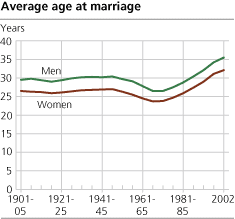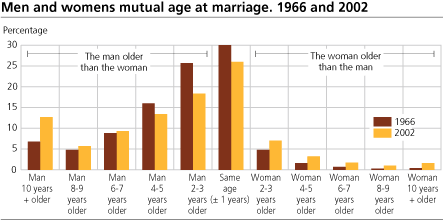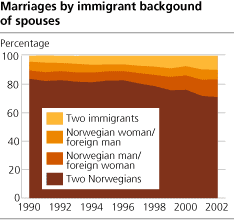Age differences at marriage
The times they are achanging?
Published:
At the beginning of the last century, men were on average almost 3.5 years older than their wives at the time of marriage. One hundred years later - with numerous and significant changes in age at the time of marriage, education levels and participation in the labour force - this age difference is almost exactly the same. Apparently.
In the period 1906-1910, the average age at marriage was 26.3 for women and 29.8 for men. Thus, men were 3.5 years older than their wives on average (applies to all marriages, both between those who had not previously been married and those who had). This pattern remained fairly stable for almost 50 years, both in terms of the age at marriage and the age difference between the bride and groom.
The age at marriage fell steadily during a period beginning around 1950 - the golden age of the nuclear family: up to the end of the 1960s, the men's age at the time of marriage fell by around 4 years to 26.5, and women's by around 3 years to 23.7. The age difference during this period also fell by a good six months.
At the beginning of the 1970s, however, this trend began to reverse: along with women's increasing education levels and participation in the labour force, more liberal abortion laws, better contraception, the increase in cohabitation outside marriage etc., the marriage age began to increase. Today, in 2002, the average age of men at the time of marriage is 35.5, and women are 32.1 on average. The increase has therefore been slightly higher for men, and the age difference between men and women is back to about the same level as 100 years ago, i.e. 3.5 years.
Similar age differences (where the man is 2-4 years older) exist in most countries and for most periods, and these differences are often explained in the following way:
|
Seemingly, the numerous and significant changes in the relationship between men and women in the last 30-40 years - especially in terms of education, participation in the labour force and income - have therefore been of little consequence with regard to the age difference at the time of marriage.
On the one hand, it could be expected that the increase in gender equality in other areas would also lead to greater gender equality with regard to the age when couples start living together; i.e. a more equal age distribution. On the other hand: to the extent that the traditional age difference was primarily that - a tradition - it could be expected that the 68 generations' rebellion against the parent generation's different forms of traditions and customs also would have led to an increased margin for greater age differences - both ways.
When the age difference between men and women appears to be constant, this is based on the average age of men and women at the time of marriage. However, this average does not necessarily reflect the age differences in individual marriages.
Examples:
Example A: Man 31 Woman 29 = difference: 2 years
Man 29 Woman 25 = difference: 4 years i.e. average age difference: 3 years
Example B: Man 35 Woman 25 = difference: 10 years
Man 25 Woman 29 = difference: - 4 years i.e. average age difference: 3 years
In example A, the average age for men is 30, women 27 and the average age difference is 3 years. The average age in example B is the same, but here the man is much older than the woman, but in the other couple the woman is older than the man. Stable average age differences can thus conceal major changes in the direction of a greater variation: more older men who are marrying younger women - and vice versa: more women marrying younger men.
More variation?
In the figure to the right, marriages entered into in 1966 and 2002 are grouped according to the ages of the bride and groom.
In 1966, marriages where the man was 2-3 years older were typical and made up a quarter of all marriages entered into. The second largest group was marriages where the man was 4-5 year older (16 per cent). Next were marriages where the man was 1 year older or 6-9 years older. The percentage of marriages entered into where the man and woman were the same age therefore amounted to a relatively small minority of 10.5.
Overall, marriages where the man was older than the woman accounted for 75 per cent, whilst the women were older than the men in only around 14 per cent of the cases, where the age difference was mainly only 1-3 years.
By 2002, this picture had changed considerably: the dissipation in age difference has increased substantially. There are more marriages being entered into where the age difference is relatively high, and the percentage of "typical” or traditional age differences in the man's favour (where the man is 2-5 years older) has dramatically declined.
The proportion of marriages entered into where the man is more than 9 years older than the woman is the group that has increased the most; by almost double. Otherwise, the most striking aspect is the systematic increase in marriages entered into where the woman is older than the man. In 1966, these accounted for 14 per cent of the marriages, and in 2002, the woman was older than the man in every fifth marriage that took place. In relative terms, the increase has been greatest for the group where the woman is 4 years older or more; this group has increased from 3 to 7.5 per cent.
Remarriage and “mail order” marriages
This change in direction of greater age differences between men and women is due to a number of factors. Amongst other things, more and more marriages are now entered into by men and/or women who have been married before: in 2002, this figure was almost 30 per cent. Those who have already been married are older, and this is one of the reasons that the age at the time of marriage has increased. With increasing age, the age differences become “minor” so to speak (they have less significance), and the number of “available” partners declines since more and more people of the same age are already married. Therefore, many men and women marry partners that are much younger 1 .
Another factor that has contributed to the increase in marriages where the man is a lot older than the woman is the increasing number of so called mail order marriages. Increasing globalisation and international mobility have gradually affected the marriage market in Norway, and in more and more marriages one or both of the parties have an immigrant background. In 2002, 7 out of 10 marriages entered into were between two Norwegian citizens, 10 per cent were marriages between two immigrants, 7 per cent were between a Norwegian woman and a foreign man, and a total of 12 per cent were between a Norwegian man and a foreign woman.
The latter group in particular has increased dramatically in recent years, with the majority of men marrying women from non-western countries, especially Thailand, Russia and the Philippines. These women are often much younger than their Norwegian husbands. Whilst the proportion of marriages where the man was at least 6 years older in marriages between two Norwegian citizens was only 20 per cent, the figure was almost 60 per cent for marriages between Norwegian men and foreign women. Additionally, in the increasing percentage of marriages between persons with an immigrant background, the man is often much older.
As regards the increasing proportion of marriages where the woman is older than the man, this is more prevalent in cases where women marry a foreign man.
1 Many people would perhaps think that unmarried cohabitants are more unconventional also in terms of the age difference. However, unmarried cohabitants are surprisingly similar to married couples with regard to age differences - with one exception: the proportion of cohabitations where the man is more than 9 years older than the woman is much lower. Since a large percentage of those who marry have been cohabiting for a shorter or longer period, it is not surprising that the age structure is about the same.
Contact
-
Statistics Norway's Information Centre



